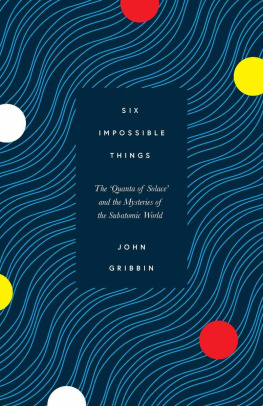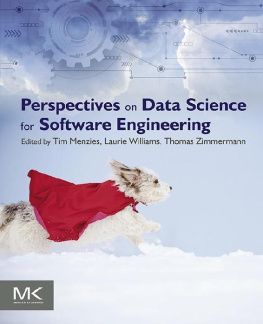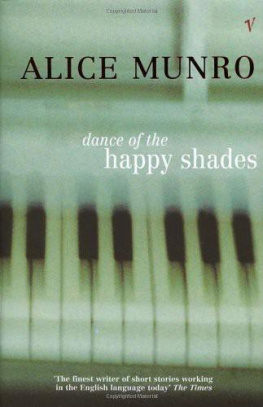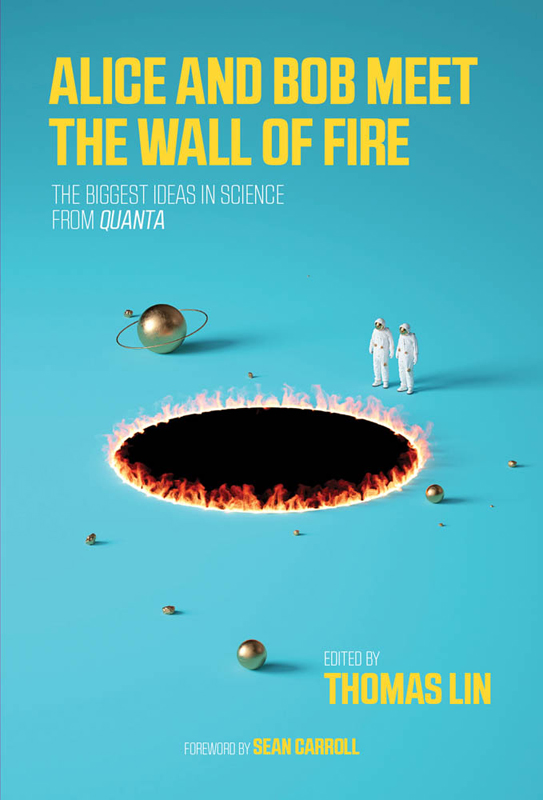Contents
Guide
Pagebreaks of the print version
ALICE AND BOB MEET THE WALL OF FIRE
The Biggest Ideas in Science fromQuanta
edited by Thomas Lin

 The MIT Press
The MIT Press
2018 The Simons Foundation, Inc.
All rights reserved. No part of this book may be reproduced in any form by any electronic or mechanical means (including photocopying, recording, or information storage and retrieval) without permission in writing from the publisher.
This book was set in Stone Serif by Westchester Publishing Services. Printed and bound in the United States of America.
Library of Congress Cataloging-in-Publication Data
Names: Lin, Thomas (Journalist), editor.
Title: Alice and Bob meet the wall of fire : the biggest ideas in science from Quanta / edited by Thomas Lin ; foreword by Sean Carroll.
Other titles: Quanta science stories
Description: Cambridge, MA : The MIT Press, [2018] | Includes bibliographical references and index.
Identifiers: LCCN 2018013315 | ISBN 9780262536349 (pbk. : alk. paper)
Subjects: LCSH: Physics--Popular works. | Biology--Popular works.
Classification: LCC QC24.5 .A445 2018 | DDC 530--dc23 LC record available at https://lccn.loc.gov/2018013315
Men fear thought as they fear nothing else on earthmore than ruin, more even than death. Thought is subversive and revolutionary, destructive and terrible; thought is merciless to privilege, established institutions, and comfortable habits; thought is anarchic and lawless, indifferent to authority, careless of the well-tried wisdom of the ages. Thought looks into the pit of hell and is not afraid. It sees man, a feeble speck, surrounded by unfathomable depths of silence; yet it bears itself proudly, as unmoved as if it were lord of the universe. Thought is great and swift and free, the light of the world, and the chief glory of man.
Bertrand Russell in Why Men Fight
CONTENTS
Sean Carroll
Thomas Lin
Natalie Wolchover
Jennifer Ouellette
K. C. Cole
Jennifer Ouellette
Natalie Wolchover
Jennifer Ouellette
Frank Wilczek
Natalie Wolchover
Dan Falk
Frank Wilczek
Philip Ball
Natalie Wolchover
George Musser
Dan Falk
Natalie Wolchover
Philip Ball
Emily Singer
Carl Zimmer
Emily Singer
Carl Zimmer
Emily Singer
Emily Singer
Ferris Jabr
Emily Singer
Emily Singer
Emily Singer
Courtney Humphries
Michael Nielsen
Natalie Wolchover
Andreas von Bubnoff
John Pavlus
Natalie Wolchover
Natalie Wolchover
Katia Moskvitch
Natalie Wolchover
Robbert Dijkgraaf
K. C. Cole
Natalie Wolchover
LIST OF ILLUSTRATIONS
Two electrons exchange a photon.
A graviton encounters a quantum fluctuation.
One way that the Higgs particle can be produced and then decay into daughter particles.
A sketch of the amplituhedron representing an 8-gluon particle interaction. Using Feynman diagrams, the same calculation would take roughly 500 pages of algebra. Courtesy of Nima Arkani-Hamed.
Expanding the genetic alphabet dramatically expands the number of possible amino acids and proteins that cells can build, at least in theory. The existing four-letter alphabet produces 20 amino acids (small circle) while a six-letter alphabet could produce 216 possible amino acids (large circle).
The genetic codemade up of the four letters, A, T, G and Cstores the blueprint for proteins. DNA is first transcribed into RNA and then translated into proteins, which fold into specific shapes.
Scientists argue about the proper position of comb jellies on the animal evolutionary tree. Recent genetic evidence suggests that comb jelly ancestorswere the first to split off from other animals. Other researchers maintain that sponges were likely first. Scientists also disagree over the origin of neurons. Were they present in the ancestor of all animals? Or did they evolve once in comb jellies and again in the ancestor to jellyfish and bilaterians?
When it comes to brains, size isnt everything. The human brain is much smaller than that of an elephant or whale. But there are far more neurons in a humans cerebral cortex than in the cortex of any other animal.
How does the number of neurons in the cerebral cortex vary with the size of that part of the brain? Different scaling rules apply. In rodents, a 10-fold increase in the number of cortical neurons leads to a 50-fold increase in the size of the cortex. In primates, by contrast, the same neural increase leads to only a 10-fold increase in cortex sizea far more economical relationship. Source: Herculano-Houzel et al. (2014)
Deep neural networks learn by adjusting the strengths of their connections to better convey input signals through multiple layers to neurons associated with the right general concepts. When data is fed into a network, each artificial neuron that fires (labeled 1) transmits signals to certain neurons in the next layer, which are likely to fire if multiple signals are received. The process filters out noise and retains only the most relevant features.
Humans can probe the universe over a vast range of scales (white area), but many modern physics theories involve scales outside of this range (gray). Icons via Freepik.
FOREWORD
Sean Carroll
Q uanta has been a revelation.
All scientists are well aware that diplomatic relations across the border between science and journalism typically range from wary to downright hostile. Its not that there is any natural antipathy between the groups, both of which largely consist of dedicated professionals pursuing an honorable craft. Scientists attempt to discover true things about the natural world and rely on journalists to spread the word of those discoveries to a wide audience; journalists hope to convey those discoveries in engaging and accurate ways and rely on scientists to help them understand and communicate. But the relevant sets of standards and incentives are different. Scientists lapse into jargon in an attempt to preserve precision, and they place enormous value on the precise attribution of credit; journalists want to tell a human story that will be compelling to nonscientists, and they are naturally drawn to the most dramatic angle that can be attached to any particular finding.
Thus, tension. Scientists find themselves insisting that the new way they have developed to slow down the speed of light through a crystal does not, in fact, open any potential routes to warp drive and/or time travel. Journalists have to gently explain that their four-paragraph story wont actually be able to list all 12 coauthors of the original study, nor will there be room to explain the finer points of adiabatic softening. Scientists reluctantly go along with this, only to be aghast when two of the four paragraphs in the final article are devoted to the whimsical antics of the new puppy one of the grad students was bringing to the lab. These are the sacrifices we make for the sake of a human-interest angle.



![Thomas W. Miller [Thomas W. Miller] - Web and Network Data Science: Modeling Techniques in Predictive Analytics](/uploads/posts/book/119619/thumbs/thomas-w-miller-thomas-w-miller-web-and.jpg)





 The MIT Press
The MIT Press